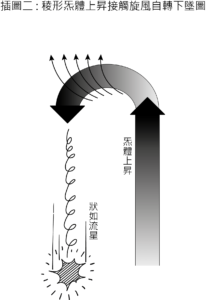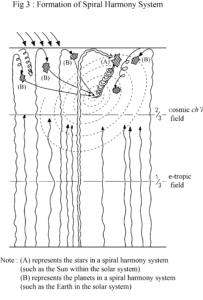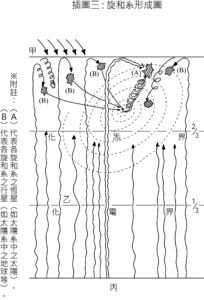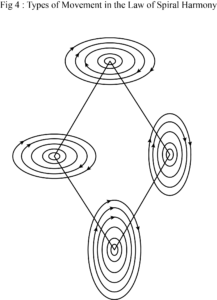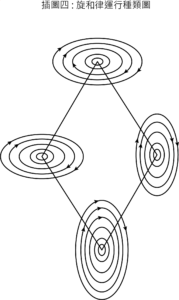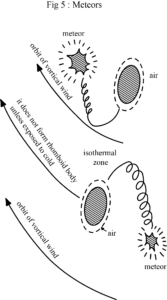第一節 旋和系之形成
A. The primordial phenomenon of chaos: Strictly speaking, there is no such phenomenon in the universe as eternal, unvarying chaos. Chaos is only the loss of spiral harmonizing force within a spiral harmony system. When a spiral system loses this force, the space in its vicinity will be a vast expanse filled with liquid. This will gradually evolve by natural means to form a new spiral harmony system in space. The basic reason a spiral harmony system stops is that its supply of aqua-essentia (hydro-electropic force) is used up. When the supply of aqua-essentia in any spiral system is exhausted, destroying the balance of its spiral harmonizing force (see D,E), the space in this system will thus be filled by a non-ordered, pervasive liquid. This is what has been termed “primordial chaos”.
甲、混沌之初象—嚴格而論,宇宙間實無永恒固定之混沌現象。混沌者,不過某一個旋和系消失其旋和力而已,在某一個旋和系消失其旋和力時,該旋和系附近範圍內之空間即為充滿洪大之液體的場所,而逐步依其自然之演化以形成宇宙間之新的旋和系統。蓋旋和力停止之基因,即為該旋和系中水分(水電力)供應之停止,是故任何旋和系中之水分的供應若一旦枯竭而打破其旋和力之動力平衡(見丁戊二段),此旋和系之空間即被漫無規律之充盪液體所瀰漫,所謂混沌是也。
B. Evolution which unfolds in e-tropicity and cosmic ch’i: In this vast world of liquid flux, constant motion and impact of e-tropons results in friction that gives off heat and this in turn gives off a dense vapor. This vapor rises upward away from the liquid. Objectively, the center should be thought of as up. Front, rear, left, right, up and down are all down [in relation to the center]. So the vapor moves centripetally. Reaching a certain level of space it gives off great amounts of e-tropic substance (with light emission). This sort of e-tropic substance is lighter than the vapor, and so it continues rising. Finally it changes into cosmic ch’i (e-tropic ch’i) which contains no water. This is termed primordial ch’i.(Fig.1)
乙、電與炁之演變—在此洪大的液體世界中,因液體中之電子常相激盪之結果,即磨擦生熱而生濃厚之蒸氣,此種蒸氣即離液體而上升,站在客觀上應以中央為上,前後左右上下,莫不為下,即是一種向心運動。至適度之空間時,復發生無數之電質(同時發光),此種電質既較蒸氣為輕,遂又繼續起昇,終至化為一種不含水分之炁體(電氣體),即所謂先天之炁是也(插圖一)。
C. Coalescence of rhomboid cosmic ch’i: When the cosmic ch’i rises to the highest level, it is on the verge of touching the space of other spiral harmony systems. Under influence of vortical wind from other spiral harmony systems, it gradually changes into coalesced rhomboid bodies (it is still e-tropic cosmic ch’i) that fall in spiral course. At the same time it emits light and heat in great quantity like the meteors often seen from our world.(Fig.2)
丙、稜形炁體之凝成—炁體一直上升至極大之高度將與其他旋和系之空界相接觸之程度,因受其他旋和系中旋風力之影響,乃逐漸化為一種稜形之凝體(仍為電炁體)而盤旋自轉下降,同時發出大量之光與熱,如人間慣見之流星(插圖二)。
D. Origination of the spiral harmonizing force: When these light-and-heat-emitting, coalesced rhomboid bodies descend to the level mentioned in Section B, where e-tropicity transforms to cosmic ch’i, there is a mutual pushing and unending spiral motion, due to collision with e-tropic substance that continues to rise from below. In this way the spiral harmonizing force arises.(Fig.3)
丁、旋和力之發生—此稜形之光熱凝體降至先前乙段所論由電化炁之高度時,因與由下而上繼續上升之電質相遇,因而交相推磨大旋不已,旋和力遂告形成(插圖三)。
E. The workings of the law of spiral harmony: Once the spiral harmonizing force originates, it is driven ceaselessly by continual rising of the cosmic ch’i and thereby gives rise to a rapidly revolving body of cosmic ch’i giving off light and heat. Also, because this body of cosmic ch’i continually embraces and interfuses conflicting elements, objects of all sizes begin to revolve around it, refine itself from large to small, first in a disorderly and then in an orderly manner. Eventually it becomes an elliptical ring which revolves without end. Thus originates the law of spiral harmony. (Fig.4)
戊、旋和律之運行—旋和力初步形成之後,因受繼續上升之炁體不斷之推動,遂自成一種以高速度旋轉之光熱炁體,並由於炁體不斷抱合沖盪之影響,由大而小,由無律的公轉而成為有律的公轉,終至形成為一種橢圓形之圈狀運行不已,而旋和律於焉告成(插圖四)。
F. The dynamics of primordial nebulae: The initial spiral harmonizing force that forms in each spiral harmony system ultimately will be the center of gravity of that system. An example is the sun within a solar system. But at the primordial nebula stage it is not solidified. At this time the center and periphery of a solar system become a vast, rapid vortex of e-tropic cosmic ch’i, somewhat like a whirlpool in water. Whatever fairly small objects happen to be nearby are drawn into the whirlpool, to revolve rapidly along with it. Thus all the smaller rhomboid cosmic bodies which rise through space and descend again will be drawn in by the spiral force which they approach and revolve unceasingly with it. This is the case with planets and satellites after formation of a solar system. Once such planets are drawn into the vortex, they move steadily in an orbit of cosmic ch’i, unable to escape (fall outward). The primitive nebula state is a rapidly-turning, unending vortex. At its center is the largest rhomboid cosmic ch’i body (a star), which is revolved by smaller rhomboid cosmic ch’i bodies at various distances. These take form as planets and satellites. A meteor is a celestial body within the system which solidifies out of rising e-tropic ch’i until it is drawn down in a spiral by the vortex within the orbit of the planet.(Fig.5)
己、原始星雲之動態—各旋和系中最初形成之旋和力,即為最後每個旋和系中之重心,亦即如太陽系中之太陽,惟在原始星雲狀態之中尚未成為固體耳。此時在太陽系之中心及周圍,為一團極洪大而猛速之旋風電炁,狀如水中之漩渦,所有漩渦附近較小之物體皆有被其捲入漩渦之中而隨之猛旋之趨勢,是故其他「一切大空中由下而上,復由上垂下之較小稜形炁體」,當其接近此旋和力之附近時,即被其旋力捲入而隨之旋轉不已,是即太陽系形成後之行星及衛星,此種行星一經旋力轉入,即不能逃出(墜下),而在炁體之軌道上經常運行。原始星雲之狀態即為一團猛旋不已之旋風,並以最大之稜形炁體(恒星)為中心,外間繞以距離不等之較小之稜形炁體,形成行星及衛星。其隕星則為各本系中由電氣上升化為固體而被行星軌道中之旋風旋落之星體(插圖五隕星圖)。
Thus celestial bodies of this area evolve from chaos into a new spiral harmony system. After its formation the new system depends on a supply of hydro-electropic force from above, below and all sides (all “below” in the broad sense), to maintain its workings as a spiral harmony system. The supply from above and below maintains its position and that from all sides insures its revolution. If the aqua essentia in the system is ever exhausted, the celestial bodies of this area will go back to chaos; its landforms will disintegrate into e-tropic ch’i and diffuse through space.
於是此一部分之天體遂由混沌演變而形成一個新的旋和系統,在新的旋和系形成之後仍須繼續仰給於其上下前後左右(即廣義的下)各方水電力動能之供給,始克維持其旋和系之運行,上下之供應使其固定,前後左右使其運行,如某一個旋和系中一旦水分竭蹶,此部份之天體即復歸於混沌,而山河大地無不毀滅化為飛散之電氣體,瀰漫於空間矣。




